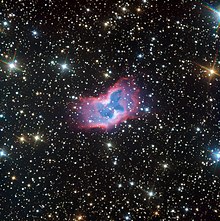
Summary
NGC 2899 is a planetary nebula in the southern constellation of Vela. It was discovered by English astronomer John Herschel on February 27, 1835.[6] This nebula can be viewed with a moderate-sized amateur telescope, but requires a larger telescope to resolve details.[3] NGC 2899 is located at a distance of 3,350 ± 670 light-years (1,026 ± 205 pc) from the Sun and 25,894 ± 3 light-years (7,939 ± 1 pc) from the Galactic Center.[2]
| Emission nebula | |
|---|---|
| Planetary nebula | |
 NGC 2899, imaged by very large telescope | |
| Observation data: J2000 epoch | |
| Right ascension | 09h 27m 03.2s[1] |
| Declination | −56° 06′ 21.1″[1] |
| Distance | 3,350 ± 670 ly (1,026 ± 205 pc)[2] ly |
| Apparent magnitude (V) | 11.8[3] |
| Apparent dimensions (V) | 2.6′ × 1.3′[4] |
| Constellation | Vela |
| Designations | NGC 2899, Gum 27, PN G277.1-03.8[5] |
This nebula has an overall kidney shape that is elongated along an axis from WNW to ESE.[7] The overall topology is bipolar with a significant equatorial structure. This shape is believed to result from a binary star system. The mean expansion rate is 43 to 56 km/s, with high velocity structures expanding at 110 to 130 km/s. The core mass of the central star is estimated as ~1.2 M☉.[4]
The nebula lies within a large cavity in the surrounding medium. This opening has quadrupolar shape with a physical dimension of 14 pc × 11 pc. The elongation lies along a position angle of 37°±5°, which is aligned with the minor axis of the planetary nebula. This opening was most likely crafted by a fast stellar wind coming from the central star during its asymptotic giant branch stage, prior to the formation of a planetary nebula. The shape and filamentary structures suggest the interaction of a binary star system.[8][9]
References edit
- ^ a b Cutri, R. M.; et al. (2003). "2MASS All-Sky Catalog of Point Sources". Vizier Online Data Catalog. Bibcode:2003yCat.2246....0C.
- ^ a b Stanghellini, Letizia; Haywood, Misha (May 2010). "The Galactic Structure and Chemical Evolution Traced by the Population of Planetary Nebulae". The Astrophysical Journal. 714 (2): 1096–1107. arXiv:1003.0759. Bibcode:2010ApJ...714.1096S. doi:10.1088/0004-637X/714/2/1096.
- ^ a b Bakich, Michael E. (2010). 1,001 Celestial Wonders to See Before You Die: The Best Sky Objects for Star Gazers. Springer New York. p. 53. ISBN 9781441917775.
- ^ a b Lopez, J. A.; et al. (January 1991). "The evolved bipolar planetary nebula NGC 2899". Astronomy and Astrophysics. 241: 526. Bibcode:1991A&A...241..526L.
- ^ "NGC 2899". SIMBAD. Centre de données astronomiques de Strasbourg. Retrieved 7 July 2015.
- ^ Seligman, Courtney. "Celestial Atlas NGC Objects 2850-2899". Retrieved 26 October 2013.
- ^ Streicher, Magda (August 2010). "The Ancient Starry Ship" (PDF). Monthly Notes of the Astronomical Society of South Africa. 69 (9 and 10): 147–152. Bibcode:2010MNSSA..69..147S. Retrieved 2024-03-13.
- ^ Weinberger, R.; Aryal, B. (July 2004). Meixner, Margaret; et al. (eds.). Huge Dust Structures and Cavities Around PNe: NGC 6826 and NGC 2899. Asymmetrical Planetary Nebulae III: Winds, Structure and the Thunderbird, Proceedings of the conference held 28 July - 1 August 2003 at Mt. Rainer, Washington, USA. ASP Conference Proceedings. Vol. 313. San Francisco: Astronomical Society of the Pacific. p. 112. Bibcode:2004ASPC..313..112W.
- ^ Aryal, B.; et al. (2009). "Planetary nebulae NGC 6826 and NGC 2899: early aspherical mass loss?". Astrophysics and Space Science. 323 (4): 323–327. Bibcode:2009Ap&SS.323..323A. doi:10.1007/s10509-009-0076-9. S2CID 121783582.
External links and images edit
- Frommert, Hartmut. "Revised NGC Data for NGC 2899". Students for the Exploration and Development of Space. Archived from the original on 7 July 2015. Retrieved 7 July 2015.
- Challis, Pete. "NGC 2899". Harvard-Smithsonian Center for Astrophysics. Retrieved 2024-03-11.
- "Stunning Space Butterfly Captured by ESO Telescope". European Southern Observatory. July 30, 2020. Retrieved 2024-03-13.


